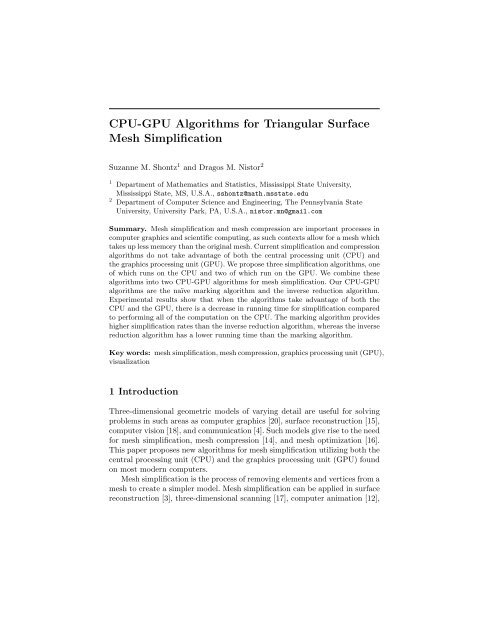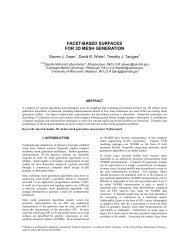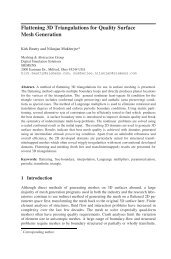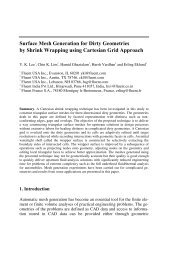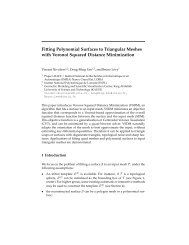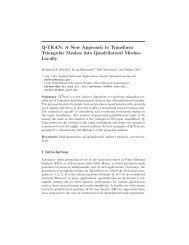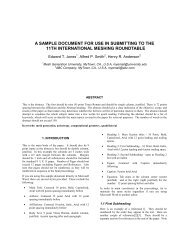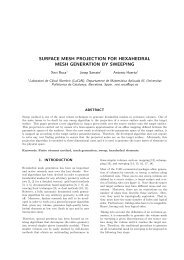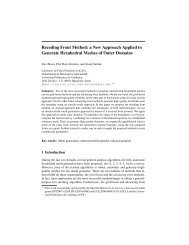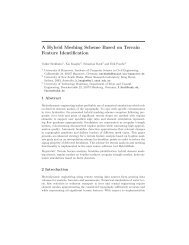CPU-GPU Algorithms for Triangular Surface Mesh Simplification
CPU-GPU Algorithms for Triangular Surface Mesh Simplification
CPU-GPU Algorithms for Triangular Surface Mesh Simplification
Create successful ePaper yourself
Turn your PDF publications into a flip-book with our unique Google optimized e-Paper software.
<strong>CPU</strong>-<strong>GPU</strong> <strong>Algorithms</strong> <strong>for</strong> <strong>Triangular</strong> <strong>Surface</strong><strong>Mesh</strong> <strong>Simplification</strong>Suzanne M. Shontz 1 and Dragos M. Nistor 21 Department of Mathematics and Statistics, Mississippi State University,Mississippi State, MS, U.S.A., sshontz@math.msstate.edu2 Department of Computer Science and Engineering, The Pennsylvania StateUniversity, University Park, PA, U.S.A., nistor.mn@gmail.comSummary. <strong>Mesh</strong> simplification and mesh compression are important processes incomputer graphics and scientific computing, as such contexts allow <strong>for</strong> a mesh whichtakes up less memory than the original mesh. Current simplification and compressionalgorithms do not take advantage of both the central processing unit (<strong>CPU</strong>) andthe graphics processing unit (<strong>GPU</strong>). We propose three simplification algorithms, oneof which runs on the <strong>CPU</strong> and two of which run on the <strong>GPU</strong>. We combine thesealgorithms into two <strong>CPU</strong>-<strong>GPU</strong> algorithms <strong>for</strong> mesh simplification. Our <strong>CPU</strong>-<strong>GPU</strong>algorithms are the naïve marking algorithm and the inverse reduction algorithm.Experimental results show that when the algorithms take advantage of both the<strong>CPU</strong> and the <strong>GPU</strong>, there is a decrease in running time <strong>for</strong> simplification comparedto per<strong>for</strong>ming all of the computation on the <strong>CPU</strong>. The marking algorithm provideshigher simplification rates than the inverse reduction algorithm, whereas the inversereduction algorithm has a lower running time than the marking algorithm.Key words: mesh simplification, mesh compression, graphics processing unit (<strong>GPU</strong>),visualization1 IntroductionThree-dimensional geometric models of varying detail are useful <strong>for</strong> solvingproblems in such areas as computer graphics [20], surface reconstruction [15],computer vision [18], and communication [4]. Such models give rise to the need<strong>for</strong> mesh simplification, mesh compression [14], and mesh optimization [16].This paper proposes new algorithms <strong>for</strong> mesh simplification utilizing both thecentral processing unit (<strong>CPU</strong>) and the graphics processing unit (<strong>GPU</strong>) foundon most modern computers.<strong>Mesh</strong> simplification is the process of removing elements and vertices from amesh to create a simpler model. <strong>Mesh</strong> simplification can be applied in surfacereconstruction [3], three-dimensional scanning [17], computer animation [12],
2 Suzanne M. Shontz and Dragos M. Nistorand terrain rendering [10]. For example, when rendering a movie scene, amodel with extremely high detail is not required <strong>for</strong> a far away object.Several serial <strong>CPU</strong>-based mesh simplification algorithms have been proposed.Some algorithms use a simple edge-collapse operation [14], which involvesrepeatedly collapsing edges into vertices to obtain a simplified mesh.Others use a triangle-collapse operation [23]. While the triangle-collapse operationyields more simplified meshes per operation [6], there are more cases tohandle when per<strong>for</strong>ming this operation. The algorithms we propose are basedon the edge-collapse operation <strong>for</strong> its simplicity.Other algorithms focus on controlled vertex, edge, or element decimation[24], where a vertex, edge, or element is removed from the mesh if it meetsthe decimation criteria. Any resulting holes in the mesh are patched throughavailable methods such as triangulation. One other method <strong>for</strong> mesh simplificationis vertex clustering [19]. When per<strong>for</strong>ming mesh simplification usingvertex clustering, vertices are clustered by topological location, and a new vertexis created to represent each cluster. Elements can then be created throughsurface reconstruction [15]. Our algorithms focus on neither decimation norclustering, as neither of these processes are designed to take advantage of theavailable <strong>GPU</strong> concurrency.A few parallel <strong>CPU</strong>-based algorithms based on the corresponding serial algorithmshave been proposed. One such parallel algorithm is based on vertexdecimation [11], where the importance of each vertex is evaluated, and verticeswith low importance are removed. A <strong>GPU</strong>-based implementation of thisalgorithm has also been proposed [13] and is discussed later in this section.However, we are interested in designing an algorithm that takes advantageof both the <strong>CPU</strong> and <strong>GPU</strong> by splitting the simplification workload betweenthem. Thus, we avoid operations which involve a significant amount of communicationbetween the <strong>CPU</strong> and <strong>GPU</strong>, as the transfer rate between the <strong>CPU</strong>and <strong>GPU</strong> is a significant bottleneck [25].Other simplification algorithms focus on distributed systems [5] and efficientcommunication between nodes. Such algorithms would suffer from thesame communication latency between the <strong>CPU</strong> and the <strong>GPU</strong> if implementedto take advantage of the <strong>GPU</strong>. Another algorithm [9] focuses on greedily splittinga mesh into equal submeshes and assigning each part to a <strong>CPU</strong> core to besimplified by applying the edge-collapse operation. These techniques could beused to implement a <strong>GPU</strong>-based algorithm. However, there is no need to createsubmeshes <strong>for</strong> such an algorithm, as the <strong>GPU</strong> can simultaneously supportmany more threads than can a multi-core <strong>CPU</strong>. Instead, each <strong>GPU</strong> threadcan focus on one element.Some <strong>GPU</strong>-based simplification algorithms have also been proposed. Onesuch algorithm offloads the computationally-intensive parts of vertex decimationto the <strong>GPU</strong> [13], while leaving the data structure representing the meshin main memory. While this approach is valid, it assumes that the <strong>CPU</strong> willbe available during the whole process. Another popular method [8] is basedon vertex clustering. A downside of this algorithm is that it assumes that the
<strong>CPU</strong>-<strong>GPU</strong> <strong>Algorithms</strong> <strong>for</strong> <strong>Triangular</strong> <strong>Surface</strong> <strong>Mesh</strong> <strong>Simplification</strong> 3surface mesh is closed and that there is access to the entire mesh during thesimplification process. This excludes streaming input models.We propose three simplification algorithms, one of which runs on the <strong>CPU</strong>and two of which run on the <strong>GPU</strong>. We combine these algorithms into two<strong>CPU</strong>-<strong>GPU</strong> algorithms <strong>for</strong> mesh simplification. The algorithms are based onthe edge-collapse operation, as it is an extremely simple and small-scale operation,and it works even if there is no access to the entire mesh. The <strong>CPU</strong>algorithm visits every available element and per<strong>for</strong>ms the edge-collapse operationon the element if it is not yet marked as affected (defined in Section2), as does one of the <strong>GPU</strong> algorithms. The other <strong>GPU</strong> algorithm takes fulladvantage of the concurrency of the <strong>GPU</strong> and attempts to collapse a greaternumber of edges each iteration.In Section 2, we present our three mesh simplification algorithms: the <strong>CPU</strong>simplification algorithm, a naïve <strong>GPU</strong> simplification algorithm, and a <strong>GPU</strong>simplification algorithm based on reductions, which we combined into two<strong>CPU</strong>-<strong>GPU</strong> algorithms. We discuss the correctness of the algorithms, as well.In Section 3, we describe our experiments to test our <strong>CPU</strong>-<strong>GPU</strong> algorithms<strong>for</strong> various <strong>CPU</strong>-<strong>GPU</strong> workload splits and then discuss our results. In Section4, we conclude our work and discuss several possibilities <strong>for</strong> future work.2 <strong>Simplification</strong> <strong>Algorithms</strong>We propose three <strong>CPU</strong>- and <strong>GPU</strong>-based algorithms which work in tandemto simplify a mesh. We combine our algorithms to produce two <strong>CPU</strong>-<strong>GPU</strong>mesh simplification algorithms. The algorithms simplify meshes uni<strong>for</strong>mly andexhaustively, ensuring maximal simplification occurs. All proposed algorithmsrely on the edge-collapse operation, which is defined below. Additionally, thealgorithms are lossless, which means that the operations can be applied inreverse, and the original mesh can be recovered.Our simplification algorithms rely on the edge-collapse operation [14],which is defined as follows <strong>for</strong> an input mesh containing a set of verticesV and a set of elements T.For an edge e = (v 1 , v 2 ) shared by elements T 1 = (v 1 , v 2 , v 3 ) and T 2 =(v 4 , v 2 , v 1 ), define v m to be the midpoint of e. To collapse edge e, T 1 and T 2are removed from the mesh, and any references to v 1 or v 2 are updated torefer to v m . Figure 1 shows an edge-collapse operation on edge (v 1 , v 2 ).For the edge-collapse operation, the order of the vertices that make upan element does not matter. If additional in<strong>for</strong>mation, such as the originalpositions of v 1 and v 2 , is stored, the edge-collapse operation is reversible.There<strong>for</strong>e, compression or simplification algorithms based on this operationare lossless, and the original mesh can be recovered by reversing these steps.Our simplification algorithms allocate a portion of the mesh to the <strong>CPU</strong>and the rest of it to the <strong>GPU</strong> to be simplified. We propose an extremelysimple method <strong>for</strong> allocation. For a <strong>CPU</strong>-<strong>GPU</strong> split k% where 0 ≤ k ≤ 100
4 Suzanne M. Shontz and Dragos M. NistorFig. 1. An edge-collapse on e = (v 1, v 2).of a mesh M = (vertices, elements), the <strong>CPU</strong> simplifies the first k% of theelements, and the <strong>GPU</strong> simplifies the remaining elements. The workload splittingis per<strong>for</strong>med once as a preprocessing step. Locks are used to ensure thatconflicting updates are not made in the simplification process.Since edge-collapse operations should be per<strong>for</strong>med uni<strong>for</strong>mly on the mesh,we mark the elements which have been affected by previous edge collapses sothat they do not take part in subsequent edge-collapse operations.Define N(T ) <strong>for</strong> T = (v a , v b , v c ) to be elements which contain any of thevertices v a , v b , or v c . If edge e = (v 1 , v 2 ) between elements T 1 = (v 1 , v 2 , v 3 )and T 2 = (v 4 , v 2 , v 1 ), <strong>for</strong> example, has been collapsed, then the elements inN(T 1 )∪N(T 2 ) are considered affected. The elements shaded in gray in Figure 2would be considered affected if edge (v 1 , v 2 ) were collapsed.Fig. 2. Elements considered affected by edge-collapse of (v 1, v 2).Since each edge-collapse operation causes neighboring elements to becomeaffected, there is a hard limit on the number of edge-collapse operations,and on the amount of simplification per<strong>for</strong>med per iteration of the algorithm.Additional simplification may be obtained by per<strong>for</strong>ming additional iterationsof the algorithms.
<strong>CPU</strong>-<strong>GPU</strong> <strong>Algorithms</strong> <strong>for</strong> <strong>Triangular</strong> <strong>Surface</strong> <strong>Mesh</strong> <strong>Simplification</strong> 52.1 <strong>CPU</strong> Edge-Collapse AlgorithmTo simplify portions of the mesh using the <strong>CPU</strong>, we propose a simple edgecollapsealgorithm. The <strong>CPU</strong> edge-collapse algorithm iterates over all <strong>CPU</strong>assignedelements. Each element is examined to see if it is affected, and ifan element T = (v 1 , v 2 , v 3 ) that is not affected is found, an edge-collapse isper<strong>for</strong>med on (v 1 , v 2 ). When all elements are affected or have taken part inan edge-collapse operation, the algorithm terminates. This ensures that theedge-collapse operation is per<strong>for</strong>med uni<strong>for</strong>mly and exhaustively across theelements assigned to the <strong>CPU</strong>, and that no one area is more or less simplifiedor de<strong>for</strong>med. Pseudocode <strong>for</strong> the <strong>CPU</strong> edge-collapse simplification algorithmis given in Algorithm 1.Algorithm 1 The <strong>CPU</strong> Edge-Collapse <strong>Simplification</strong> Algorithmfunction mark-as-affected(element)<strong>for</strong> all v ∈ element doaffected[v] ← trueend <strong>for</strong>end functionfunction mark-as-collapsed((v 1, v 2))<strong>for</strong> all T ∈ elements ⊃ {v 1, v 2} docollapsed[T ] ← trueend <strong>for</strong>end functionfunction <strong>CPU</strong>-Simplify(elements, vertices)<strong>for</strong> all T = (v 1, v 2, v 3) ∈ elements doif T ∈N(affected elements) thenmark-as-affected(T )elsecollapse((v 1, v 2))mark-as-collapsed((v 1, v 2))end ifend <strong>for</strong>end function2.2 <strong>GPU</strong> Marking AlgorithmWe propose a naïve <strong>GPU</strong> algorithm to simplify portions of the mesh based onthe edge-collapse operation. The naïve <strong>GPU</strong> marking simplification algorithmworks by searching through all elements assigned to the <strong>GPU</strong> one at a time.If an element T = (v 1 , v 2 , v 3 ) that is not affected is found, an edge-collapseis per<strong>for</strong>med on (v 1 , v 2 ), and all T n ∈ N(T ) are concurrently marked as affected.When all elements are affected or have taken part in an edge-collapse
6 Suzanne M. Shontz and Dragos M. Nistoroperation, the algorithm terminates. This also ensures that the edge-collapseoperation is per<strong>for</strong>med uni<strong>for</strong>mly and exhaustively across all elements assignedto the <strong>GPU</strong>, and that no one area is more or less simplified or de<strong>for</strong>med. Thepseudocode <strong>for</strong> the naïve <strong>GPU</strong> marking simplification algorithm is given inAlgorithm 2.Algorithm 2 The <strong>GPU</strong> Marking <strong>Simplification</strong> Algorithmfunction <strong>GPU</strong>-Mark(mark, elements, vertices)<strong>for</strong> all T ∈ N(mark) do <strong>GPU</strong> thread T : mark-as-affected(T )end <strong>for</strong>end functionfunction <strong>GPU</strong>-Mark-Simplify(elements, vertices)<strong>for</strong> all T = (v 1, v 2, v 3) ∈ elements doif not marked(T ) thencollapse((v 1, v 2))mark-as-collapsed((v 1, v 2))<strong>GPU</strong>-Mark(T )end ifend <strong>for</strong>end function2.3 <strong>GPU</strong> Inverse Reduction AlgorithmWe propose a <strong>GPU</strong> mesh simplification algorithm that leverages the fullstrength of the <strong>GPU</strong>. Unlike our previous algorithms in which one elementwas examined at each iteration of the main loop to determine which elementswere not affected, we now examine twice as many elements per iteration, witheach element examined by a different <strong>GPU</strong> thread. To take full advantageof the architecture of the <strong>GPU</strong>, a soft-grained blocking [21] method based ontest-and-set [1] is used to decide if any edge of an element should be collapsed.We attempt to lock each vertex in an element by calling test-and-set on theaffected bit of each vertex in the element. Pseudocode <strong>for</strong> the <strong>GPU</strong> inversereduction simplification algorithm is given in Algorithm 3.Correctness. The <strong>GPU</strong>-Simp-Try method attempts to lock each vertex ofan element by checking to make sure the vertex has not already been collapsed.If it finds that a vertex has already been locked, it releases all previously-lockedvertices. There<strong>for</strong>e, if a thread successfully locks v 1 , v 2 , and v 3 <strong>for</strong> element t,this means that no other thread has locked any t n ∈ N(t), either currently orpreviously. There<strong>for</strong>e, the algorithm simplifies the mesh both uni<strong>for</strong>mly andexhaustively, ensuring that no one area is too simplified or de<strong>for</strong>med.
<strong>CPU</strong>-<strong>GPU</strong> <strong>Algorithms</strong> <strong>for</strong> <strong>Triangular</strong> <strong>Surface</strong> <strong>Mesh</strong> <strong>Simplification</strong> 7Algorithm 3 The <strong>GPU</strong> Inverse Reduction <strong>Simplification</strong> Algorithmfunction <strong>GPU</strong>-Simp-Try(target = (v 0, v 1, v 2), elements, vertices)if affected(target) thenreturnend ifif test-and-set(collapsed[v 0]) = 0 thenif test-and-set(collapsed[v 1]) = 0 thenif test-and-set(collapsed[v 2]) = 0 thencollapse((v 0, v 1))<strong>GPU</strong>-Mark(target)end ifcollapsed[v 1] ← 0collapsed[v 0] ← 0end ifcollapsed[v 0] ← 0end ifend functionfunction <strong>GPU</strong>-IR-Simplify(elements, vertices)i = |elements|while i ≥ 1 doif threadid mod i = 0 then<strong>GPU</strong>-Simp-Try(elements[threadid])end ifi = i div 2end whileend function3 ExperimentsIn this section, we describe the experiments which we designed to test theper<strong>for</strong>mance of our mesh simplification algorithms. We implemented our meshsimplification algorithms in C++ and compiled then using the NVIDIA C++compiler included with the CUDA Toolkit [7]. We tested our algorithms on thefollowing six triangular surface meshes from computer graphics: armadillo [26],bunny [26], gargoyle [2], hand [22], horse [22], and kitten [2], which are shownin Figure 3. The computer used <strong>for</strong> our experiments was a Dell XPS 17 laptoprunning Windows 7 Professional equipped with an NVIDIA GeForce GT 550M<strong>GPU</strong> and an Intel Core i5-2430M <strong>CPU</strong> running at 2.4 GHz with 3.90 GB ofusable main memory.The goals of our experiments were to determine how much simplificationthe meshes could withstand, how much time it takes to simplify the meshes<strong>for</strong> various <strong>CPU</strong>-<strong>GPU</strong> splits, and how much memory is required <strong>for</strong> various<strong>CPU</strong>-<strong>GPU</strong> splits to simplify the meshes using each algorithm.For each mesh produced by our mesh simplification algorithms, we determinethe numbers of vertices and elements, the minimum and maximum
8 Suzanne M. Shontz and Dragos M. Nistor(a) Armadillo (b) Bunny (c) Gargoyle(d) Hand (e) Horse (f) KittenFig. 3. Initial test meshes.element angles (in degrees), the minimum and average element areas, the meshvolume, and the wall clock time (measured in seconds) <strong>for</strong> each algorithm. Usingthese metrics, we were able to assess the quality of the meshes and thealgorithmic efficiency. For the wall clock time, we report averages over 100runs of the algorithm. Table 1 contains the values of the metrics <strong>for</strong> the initialmeshes.mesh # vertices # faces min ∠ max ∠ min area avg area volumearmadillo 172974 345944 0.034750 170.907 7.424e-08 1.840e-1 1.42690e+6bunny 34834 69664 0.494800 177.515 7.925e-08 1.573e-2 7.54700e+3gargoyle 863182 1726364 0.000215 179.820 3.638e-12 4.553e-2 1.63730e+6hand 327323 654666 0.545000 177.995 5.161e-11 1.078e-4 1.64936e+1horse 15366 30728 0.385500 177.119 1.118e-14 2.118e-6 1.58866e-3kitten 137098 274196 0.004609 179.936 1.427e-08 8.846e-2 8.38625e+5Table 1. Metric values <strong>for</strong> the initial meshes.To examine the effects of splitting the mesh simplification workload betweenthe <strong>CPU</strong> and the <strong>GPU</strong> using the naïve marking algorithm, we comparedthe time spent during the simplification process <strong>for</strong> the following <strong>CPU</strong>-<strong>GPU</strong>workload splits 100-0, 95-5, 90-10, . . . , and 0-100 on each test case. The timetaken in seconds <strong>for</strong> the tested <strong>CPU</strong>-<strong>GPU</strong> splits <strong>for</strong> the bunny and gargoylemeshes can be seen in Figure 4. Such results are representative of those obtainedon small and large meshes, respectively. The percentage of runningtime spent in the <strong>GPU</strong> is shown in Table 2; the 100-0 split is not shown since
<strong>CPU</strong>-<strong>GPU</strong> <strong>Algorithms</strong> <strong>for</strong> <strong>Triangular</strong> <strong>Surface</strong> <strong>Mesh</strong> <strong>Simplification</strong> 9all of the time is spent on the <strong>CPU</strong>. The <strong>GPU</strong> memory usage <strong>for</strong> the testedsplits is shown in Table 3.(a) Bunny(b) GargoyleFig. 4. The time taken to simplify the bunny and gargoyle meshes <strong>for</strong> each <strong>CPU</strong>-<strong>GPU</strong> split using the <strong>CPU</strong>-<strong>GPU</strong> naïve marking algorithm. As the <strong>CPU</strong>-<strong>GPU</strong> splitincreases, the <strong>CPU</strong> workload increases, and the <strong>GPU</strong> workload decreases.% of <strong>GPU</strong> timemesh 95-5 90-10 85-15 80-20 75-25 70-30 65-35 60-40 55-45 50-50armadillo 9.2 14.5 19.6 24.6 29.4 34.1 38.6 43.1 47.5 51.7bunny 5.4 8.8 12.1 15.2 18.2 21.1 23.9 26.5 29.0 31.4gargoyle 10.4 15.8 21.1 26.3 31.3 36.1 40.8 45.4 49.9 54.3hand 9.4 14.8 20.0 25.1 29.9 34.7 39.3 43.9 48.4 52.7horse 5.0 8.0 10.9 13.6 16.2 18.7 21.1 23.3 25.4 27.4kitten 8.2 13.4 18.4 23.2 27.9 32.5 36.8 41.2 45.5 49.6mesh 45-55 40-60 35-65 30-70 25-75 20-80 15-85 10-90 5-95 0-100armadillo 55.8 59.8 63.6 67.4 70.9 74.3 77.5 80.6 83.4 86.0bunny 33.6 35.7 37.7 39.5 41.3 42.9 44.4 45.8 47.2 48.5gargoyle 58.6 62.7 66.7 70.5 74.2 77.7 81.0 84.2 87.2 89.1hand 56.9 61.0 64.8 68.7 72.3 75.8 79.0 82.2 84.2 87.8horse 29.2 30.9 32.5 33.9 35.3 36.5 37.6 38.6 39.4 40.1kitten 53.6 57.4 61.1 64.8 68.2 71.4 74.5 77.4 80.1 82.5Table 2. The percentage of time spent on the <strong>GPU</strong> <strong>for</strong> various <strong>CPU</strong>-<strong>GPU</strong> splitsusing the <strong>CPU</strong>-<strong>GPU</strong> naïve marking algorithm.As seen in Figure 4, the gargoyle mesh shows an increase in running time,whereas the bunny mesh exhibits a decrease in running time, with respectto increasing the workload of the <strong>GPU</strong>. This indicates that if the mesh is
10 Suzanne M. Shontz and Dragos M. NistorAmount of memory used on the <strong>GPU</strong> (KB)mesh 95-5 90-10 85-15 80-20 75-25 70-30 65-35 60-40 55-45 50-50armadillo 2568 2770 2973 3176 3378 3581 3784 3986 4189 4392bunny 517 558 599 640 680 721 762 803 844 884gargoyle 12813 13824 14836 15847 16859 17871 18882 19894 20905 21917hand 4859 5242 5626 6009 6393 6777 7160 7544 7927 8311horse 228 246 264 282 300 318 336 354 372 390kitten 2035 2196 2356 2517 2678 2838 2999 3160 3320 3481mesh 45-55 40-60 35-65 30-70 25-75 20-80 15-85 10-90 5-95 0-100armadillo 4595 4797 5000 5203 5405 5608 5811 6014 6216 6419bunny 925 966 1007 1048 1089 1129 1170 1211 1252 1293gargoyle 22928 23940 24951 25963 26974 27986 28998 30009 31021 32032hand 8695 9078 9462 9845 10229 10613 10996 11380 11763 12147horse 408 426 444 462 480 498 516 534 552 570kitten 3642 3802 3963 4124 4284 4445 4606 4766 4927 5088Table 3. The amount of memory used, in KB, by the <strong>GPU</strong> during simplification <strong>for</strong>each <strong>CPU</strong>-<strong>GPU</strong> split <strong>for</strong> both the <strong>CPU</strong>-<strong>GPU</strong> naïve algorithm and the <strong>CPU</strong>-<strong>GPU</strong>inverse reduction algorithm.large, the running time decreases as the <strong>GPU</strong> workload increases, whereas ifthe mesh is small, the reverse is true. This can be attributed to the extratime taken to allocate memory in the <strong>GPU</strong> and to copy the data from mainmemory to the <strong>GPU</strong> cache in addition to the time required <strong>for</strong> simplification.We obtain the following metrics after 10 iterations of the algorithm with a<strong>CPU</strong>-<strong>GPU</strong> split of 0-100: numbers of vertices and faces, minimum and maximumelement ages, minimum and average element areas, mesh volume, andthe percentages of vertex and face simplification. The values of the metricscan be seen in Table 4.<strong>Simplification</strong> using the <strong>CPU</strong>-<strong>GPU</strong> naïve marking algorithm does not affectthe mesh volume significantly. It does, however, increase the average areaof each element, which is to be expected. Additionally, the simplification rateis approximately 14% to 15% <strong>for</strong> one iteration of the algorithm.mesh # vertices # faces min ∠ max ∠ min area avg area volumearmadillo 56469 111617 3.091e-2 179.86 3.901e-07 6.077e-1 1.42548e+6bunny 9979 20129 1.477e-1 179.645 6.242e-06 5.759e-2 7.56014e+3gargoyle 278305 629188 3.688e-4 179.981 8.967e-08 1.143e-1 1.64053e+6hand 99635 213061 1.969e-2 179.912 2.674e-09 3.937e-4 1.65117e+1horse 5428 10927 1.874e-2 179.339 1.032e-11 7.162e-6 1.58650e-3kitten 39991 87997 1.530e-2 179.799 2.320e-06 5.259e-1 8.38547e+5Table 4. Metric values <strong>for</strong> the meshes after 10 iterations of the naïve <strong>CPU</strong>-<strong>GPU</strong>marking algorithm.
<strong>CPU</strong>-<strong>GPU</strong> <strong>Algorithms</strong> <strong>for</strong> <strong>Triangular</strong> <strong>Surface</strong> <strong>Mesh</strong> <strong>Simplification</strong> 11We also consider the simplification rate after per<strong>for</strong>ming multiple iterationsof the naïve <strong>CPU</strong>-<strong>GPU</strong> marking algorithm on the test meshes. Thesimplification rates <strong>for</strong> 10 iterations of the algorithm run on the bunny andgargoyle meshes can be see in Tables 5 and 6, respectively.(a) Bunny(b) GargoyleFig. 5. The resulting meshes after three iterations of the <strong>CPU</strong>-<strong>GPU</strong> naïve markingalgorithm.<strong>Simplification</strong> Percentage<strong>Simplification</strong> PercentageNaïve Marking Algorithm Inverse Reduction Algorithmiter # vertices # faces %v simp %f simp # vertices # faces %v simp %f simp0 34834 69664 — — 34834 69664 — —1 30102 60194 13.6 13.6 31442 62278 10.6 10.62 26103 52183 25.1 25.1 27980 55954 19.7 19.73 22772 45487 34.6 34.7 25216 50383 27.6 27.74 19976 39846 42.7 42.8 22809 45567 34.5 34.65 17603 35026 49.5 49.7 20657 41261 40.7 40.86 15588 30942 55.3 55.6 18762 37463 46.1 46.27 13870 27413 60.2 60.6 17069 34064 51.0 51.18 12396 24391 64.4 65.0 15548 31013 55.4 55.59 11093 21703 68.2 68.8 14230 28349 59.1 59.310 9979 20129 71.4 71.1 13043 25936 62.6 62.8Table 5. The simplification percentages of the bunny mesh over multiple iterationsof the <strong>CPU</strong>-<strong>GPU</strong> naïve marking algorithm and the <strong>CPU</strong>-<strong>GPU</strong> inverse reductionalgorithm.The simplification rate hovers around 64% to 71% <strong>for</strong> both vertices andfaces after 10 iterations. After three iterations, we can see that there are visibleareas where simplification occurred on the bunny mesh as shown in Figure 5.This is not the case on the larger meshes. After 10 iterations, the bunny, horse,and kitten meshes as shown in Figure 6 exhibit an extreme loss of detail. Thearmadillo lost some detail in the head area, and the other meshes do not show
12 Suzanne M. Shontz and Dragos M. Nistor<strong>Simplification</strong> Percentage<strong>Simplification</strong> PercentageNaïve Marking Algorithm Inverse Reduction Algorithmiter # vertices # faces %v simp %f simp # vertices # faces %v simp %f simp0 863182 1726364 — — 863182 1726364 — —1 735345 1470688 14.8 14.8 779354 1558590 9.7 9.72 646764 1292036 25.1 25.2 704379 1408640 18.4 18.43 573431 1142601 33.6 33.8 639370 1276589 25.9 26.14 512166 1042650 40.7 39.6 581774 1161369 32.6 32.75 458718 952966 46.9 44.8 531048 1059586 38.5 38.66 412135 872794 52.3 49.4 486874 970716 43.6 43.87 371523 801356 57.0 53.6 446693 889413 48.3 48.58 336120 737405 61.1 57.3 410960 816781 52.4 52.79 305243 680268 64.6 60.6 379788 753007 56.0 56.410 278305 629188 67.8 63.6 351150 693992 59.3 59.8Table 6. The simplification percentage of the gargoyle mesh over multiple iterationsof the <strong>CPU</strong>-<strong>GPU</strong> naïve marking algorithm and the <strong>CPU</strong>-<strong>GPU</strong> inverse reductionalgorithm.too much loss of detail. This rein<strong>for</strong>ces the notion that larger meshes can besimplified more without seeing any visible effects.(a) Armadillo (b) Bunny (c) Gargoyle(d) Hand (e) Horse (f) KittenFig. 6. The resulting meshes after 10 iterations of the <strong>CPU</strong>-<strong>GPU</strong> naïve markingalgorithm.Tables 5 and 6 show the vertex and face simplification percentages as afunction of iteration in each mesh. Note that %v simp and %f simp represent
<strong>CPU</strong>-<strong>GPU</strong> <strong>Algorithms</strong> <strong>for</strong> <strong>Triangular</strong> <strong>Surface</strong> <strong>Mesh</strong> <strong>Simplification</strong> 13the percentages of vertex and face simplification, respectively, in these tables.The amount of simplification per<strong>for</strong>med each iteration decreases. This suggeststhat as the vertex and element counts increase, the decrease in runningtime achieved by using the <strong>GPU</strong> simplification algorithm instead of the <strong>CPU</strong>simplification algorithm increases as well.To examine the effects of splitting the mesh simplification workload betweenthe <strong>CPU</strong> and the <strong>GPU</strong> using the inverse reduction algorithm, werecorded the time spent during the simplification process <strong>for</strong> various <strong>CPU</strong>-<strong>GPU</strong> splits on all test cases. We tested the following <strong>CPU</strong>-<strong>GPU</strong> workloadsplits: 100-0, 95-5, 90-10, . . . , and 0-100. The time taken in seconds <strong>for</strong> the<strong>CPU</strong>-<strong>GPU</strong> splits can be seen in Figure 7. The proportion of running timespent in the <strong>GPU</strong> <strong>for</strong> the tested is shown in Table 7. The <strong>GPU</strong> memory usage<strong>for</strong> the tested splits is shown in Table 3.(a) Bunny(b) GargoyleFig. 7. The time taken to simplify each test case <strong>for</strong> every split using the <strong>CPU</strong>-<strong>GPU</strong>inverse reduction algorithm. As the <strong>CPU</strong>-<strong>GPU</strong> split increases, the <strong>CPU</strong> workloadincreases, and the <strong>GPU</strong> workload decreases.The <strong>CPU</strong>-<strong>GPU</strong> inverse reduction algorithm shows an increase in runningtime on the horse mesh, whereas it shows a decrease in running time onthe armadillo, bunny, gargoyle, hand, and kitten meshes with respect to anincreasing workload on the <strong>GPU</strong>. If the mesh is large, the time taken decreasesas the <strong>GPU</strong> workload increases. If the mesh is small, the reverse trend holds.This is due to the extra time taken <strong>for</strong> memory allocation in the <strong>GPU</strong> and<strong>for</strong> copying the data from main memory to the <strong>GPU</strong> cache, shown in Table 3,in addition to the time required <strong>for</strong> simplification. Also, because the inversereduction algorithm is more efficient than the naïve marking algorithm, wesee that the time taken to simplify the bunny mesh decreases as the <strong>GPU</strong>workload increases, now decreasing anywhere between 5.55% <strong>for</strong> the bunnymesh to 11.48% <strong>for</strong> the gargoyle mesh when the <strong>GPU</strong> is given the full workloadwhen compared to the naïve algorithm.
14 Suzanne M. Shontz and Dragos M. Nistor% <strong>GPU</strong> timemesh 95-5 90-10 85-15 80-20 75-25 70-30 65-35 60-40 55-45 50-50armadillo 8.2 13.3 18.2 22.8 27.4 31.9 36.2 40.5 44.7 48.7bunny 5.0 8.3 11.5 14.4 17.3 20.1 22.7 25.5 27.6 29.8gargoyle 9.2 14.4 19.5 24.4 29.2 33.8 38.3 42.6 46.8 51.0hand 8.3 13.5 18.4 23.1 27.8 32.5 36.9 41.3 45.6 49.7horse 4.7 7.7 10.5 13.1 15.7 18.1 20.4 22.5 24.6 26.5kitten 7.4 12.4 17.2 21.8 26.3 30.7 34.8 38.9 43.0 46.8mesh 45-55 40-60 35-65 30-70 25-75 20-80 15-85 10-90 5-95 0-100armadillo 52.6 56.4 59.8 63.4 66.7 69.7 72.4 75.0 77.2 79.0bunny 31.9 33.9 35.7 37.4 39.1 40.5 41.9 43.2 44.5 45.7gargoyle 55.1 58.9 62.7 66.2 69.7 73.0 76.0 79.0 81.7 83.4hand 53.7 57.6 61.1 64.9 68.3 71.4 74.2 76.9 79.2 81.1horse 28.2 28.8 31.4 32.6 33.9 34.9 35.9 36.8 37.5 38.1kitten 50.7 54.3 57.8 61.3 64.5 67.5 70.3 73.0 75.6 77.1Table 7. The percentage of time spent using the <strong>GPU</strong> <strong>for</strong> various <strong>CPU</strong>-<strong>GPU</strong> splitsusing the inverse reduction algorithm.The following metrics were collected after 10 iterations of the algorithmwith a <strong>CPU</strong>-<strong>GPU</strong> split of 0-100: vertex and face counts, minimum and maximumelement angles (in degrees), minimum and average element area, meshvolume, and vertex and face simplification percentages. The values <strong>for</strong> thesemetrics <strong>for</strong> the tenth iteration can be seen in Table 8.mesh # vertices # faces min ∠ max ∠ min area avg area volumearmadillo 65091 129131 2.271e-2 179.949 1.656e-07 5.190e-1 1.42659e+6bunny 13043 25936 5.214e-2 179.805 1.000e-07 4.455e-2 7.55771e+3gargoyle 351150 693992 3.044e-3 179.991 3.046e-08 1.211e-1 1.64145e+6hand 132063 259374 1.449e-2 179.920 8.594e-10 2.940e-4 1.64892e+1horse 6623 12719 1.251e-2 179.520 6.054e-11 5.698e-6 1.58656e-3kitten 53725 106863 1.076e-2 179.912 1.476e-06 2.404e-1 8.38289e+5Table 8. Values of the metrics <strong>for</strong> the meshes after 10 iterations of the <strong>CPU</strong>-<strong>GPU</strong>inverse reduction algorithm.<strong>Simplification</strong> using the inverse reduction algorithm does not affect thevolume of the test cases significantly. It does, however, increase the averagearea of each element, which is to be expected. Additionally, the simplificationrate is approximately 9% to 10% after one iteration of the algorithm, which ismuch lower than that of the naïve algorithm. This demonstrates the tradeoffbetween speed and rate of compression.We also consider the simplification rate after per<strong>for</strong>ming 10 iterations ofthe <strong>CPU</strong>-<strong>GPU</strong> inverse reduction algorithm on the test meshes. The simplifi-
<strong>CPU</strong>-<strong>GPU</strong> <strong>Algorithms</strong> <strong>for</strong> <strong>Triangular</strong> <strong>Surface</strong> <strong>Mesh</strong> <strong>Simplification</strong> 15cation rates <strong>for</strong> per<strong>for</strong>ming 10 iterations of the algorithm on the bunny andgargoyle meshes can be seen in Tables 5 and 6, respectively.(a) Bunny(b) GargoyleFig. 8. The resulting meshes after three iterations of the <strong>CPU</strong>-<strong>GPU</strong> inverse reductionalgorithm.The simplification rate <strong>for</strong> both vertices and faces after 10 iterations of thealgorithm hovers around 57% to 63%. After three iterations, there are visibleareas where repeated simplification occurred on the bunny mesh as shown inFigure 8, but this is not the case on the larger meshes. After 10 iterations, thebunny, horse, and kitten meshes exhibit an extreme loss of detail, as shown inFigure 9. The armadillo lost some detail in the head; the other meshes do notshow too much loss of detail. This suggests that the larger a mesh is initially,the more that it can be simplified without any visible negative effects.Table 7 shows the simplification percentages as a function of the numberof iterations <strong>for</strong> the vertices and faces in each mesh. The simplification percentagesincrease at a decreasing rate. This suggests that as a mesh increasesin size, the decrease in running time achieved by using the <strong>GPU</strong> simplificationalgorithm instead of the <strong>CPU</strong> simplification algorithm increases as well.4 Conclusions and Future WorkIn this paper, we have proposed two lossless <strong>CPU</strong>-<strong>GPU</strong> surface mesh simplificationalgorithms. Our algorithms are based on the <strong>GPU</strong> marking algorithm,which uses multiple <strong>GPU</strong> threads to concurrently mark elements as affected,and the <strong>GPU</strong> inverse reduction algorithm, which attempts to per<strong>for</strong>m theedge-collapse operation on twice as many edges at each step compared to <strong>GPU</strong>marking algorithm. Both algorithms were tested on numerous triangular surfacemeshes from computer graphics. The combinations of the <strong>CPU</strong> algorithmwith the two <strong>GPU</strong> algorithms are novel. In particular, the <strong>CPU</strong>-<strong>GPU</strong> algorithmsleverage the concurrency of the <strong>GPU</strong> to accelerate the simplification ofour surface meshes. The algorithms can be used in various areas of computergraphics, such as video games and computer imaging, where there is a clearbenefit in creating a series of meshes from a single source mesh or a simplified
16 Suzanne M. Shontz and Dragos M. Nistor(a) Armadillo (b) Bunny (c) Gargoyle(d) Hand (e) Horse (f) KittenFig. 9. The resulting meshes after 10 iterations of the <strong>CPU</strong>-<strong>GPU</strong> inverse reductionalgorithm.version of an original mesh. They may also be useful <strong>for</strong> real-time visualizationof triangular surface meshes used in scientific computing applications.The simplification rate and running time of the <strong>CPU</strong>-<strong>GPU</strong> algorithmsdepended on multiple factors, including the <strong>GPU</strong> algorithm selected. Both<strong>CPU</strong>-<strong>GPU</strong> algorithms used the same amount of <strong>GPU</strong> memory <strong>for</strong> any specific<strong>CPU</strong>-<strong>GPU</strong> split, as they both needed to keep track of the same numbers ofvertices and elements on the <strong>GPU</strong>. As the <strong>GPU</strong> workload was increased, theamount of <strong>GPU</strong> memory used increased as well. For both algorithms, as thesize of a mesh increased, the decrease in simplification time increased, asthe <strong>GPU</strong> workload was increased. The simplification rate of approximately68% that the <strong>CPU</strong>-<strong>GPU</strong> marking algorithm achieved was higher than thesimplification rate of approximately 59% that was achieved by the inversereduction algorithm, over ten iterations. This slight increase in simplificationrate provided by the marking algorithm was counterbalanced by an increaseof 5.55% to 11.48% in the running time when the <strong>GPU</strong> was given the fullworkload. Further simplification is possible if the simplification algorithm wererun <strong>for</strong> a larger number of iterations. This suggests that the <strong>GPU</strong> markingalgorithm should be used when a larger simplification rate per iteration isneeded and running time is not a limiting factor. However, the <strong>GPU</strong> inversereduction algorithm should be used when time is a limiting factor or when alesser simplification rate per iteration is required, such as <strong>for</strong> smaller meshes.Our results show that certain areas of the surface mesh were repeatedlysimplified over multiple iterations, causing the meshes to look excessively simplifiedin these areas, since element ordering determines the simplification
<strong>CPU</strong>-<strong>GPU</strong> <strong>Algorithms</strong> <strong>for</strong> <strong>Triangular</strong> <strong>Surface</strong> <strong>Mesh</strong> <strong>Simplification</strong> 17order. Reordering the mesh elements as a preprocessing step would likelyminimize the repeated simplification of mesh elements in a given area. <strong>Mesh</strong>optimization may also be useful <strong>for</strong> improving the quality of the surface meshelements.It would also be interesting to implement a hybrid mesh simplificationalgorithm that takes advantage of the speed of the <strong>GPU</strong> inverse reductionalgorithm and the simplification rate of the <strong>GPU</strong> marking algorithm. Thiscould potentially increase the simplification rate as well as decrease the runningtime of the simplification algorithm. Further algorithmic speed may beaccomplished through the utilization of additional <strong>CPU</strong> cores or additional<strong>GPU</strong>s, which could take full advantage of parallelism. This may prove to be especiallyuseful <strong>for</strong> real-time graphics and scientific visualization applications.5 AcknowledgementsThe work of the first author is supported in part by NSF grants CNS-0720749and NSF CAREER Award OCI-1054459.References1. Y. Afek, E. Gafni, J. Tromp, and P. Vitany. Wait-free test-and-set. In AdrianSegall and Shmuel Zaks, editors, Distributed <strong>Algorithms</strong>, volume 647 of LectureNotes in Computer Science, pages 85–94. Springer Berlin / Heidelberg, 1992.2. AIM@SHAPE. Aim@shape shape repository 4.0, February 2012.http://shapes.aimatshape.net/.3. M.-E. Algorri and F. Schmitt. <strong>Mesh</strong> simplification. Computer Graphics Forum,15(3):77–86, 1996.4. C.L. Bajaj, V. Pascucci, and G. Zhuang. Progressive compression and transmissionof arbitrary triangular meshes. In Proc. Visualization ’99, Visualization’99, pages 307–537, 1999.5. D. Brodsky and J.B. Pedersen. A parallel framework <strong>for</strong> simplification of massivemeshes. In Proc. of the 2003 IEEE Symposium on Parallel and Large-DataVisualization and Graphics, PVG ’03, pages 17–24, Washington, DC, USA, 2003.IEEE Computer Society.6. P. Cignoni, C. Montani, and R. Scopigno. A comparison of mesh simplificationalgorithms. Computers & Graphics, 22:37–54, 1997.7. NVIDIA Corporation. CUDA Toolkit, January 2012.http://developer.nvidia.com/cuda-toolkit-41.8. C. DeCoro and N. Tatarchuk. Real-time mesh simplification using the <strong>GPU</strong>. InProc. of the 2007 Symposium on Interactive 3D Graphics and Games, I3D ’07,pages 161–166, New York, NY, USA, 2007. ACM.9. F. Dehne, C. Langis, and G. Roth. <strong>Mesh</strong> simplification in parallel. In ICA3PP’00, pages 281–290, 2000.10. C. Dick, J. Schneider, and R. Westermann. Efficient geometry compression <strong>for</strong><strong>GPU</strong>-based decoding in realtime terrain rendering. Computer Graphics Forum,28(1):67–83, 2009.
18 Suzanne M. Shontz and Dragos M. Nistor11. M. Franc and V. Skala. Parallel triangular mesh decimation without sorting. InProc. of the 17th Spring Conference on Computer Graphics, SCCG ’01, pages22–, Washington, DC, USA, 2001. IEEE Computer Society.12. P. Heckbert and M. Garl. Multiresolution modeling <strong>for</strong> fast rendering. InProceedings of Graphics Interface, pages 43–50, 1994.13. J. Hjelmervik and J.-C. Leon. <strong>GPU</strong>-accelerated shape simplification <strong>for</strong>mechanical-based applications. In Proc. of the IEEE International Conferenceon Shape Modeling and Applications 2007, SMI ’07, pages 91–102, Washington,DC, USA, 2007. IEEE Computer Society.14. H. Hoppe. Progressive meshes. In Proceedings of the 23rd Annual Conference onComputer Graphics and Interactive Techniques, SIGGRAPH ’96, pages 99–108,New York, NY, USA, 1996. ACM.15. H. Hoppe, T. DeRose, T. Duchamp, J. McDonald, and W. Stuetzle. <strong>Surface</strong> reconstructionfrom unorganized points. SIGGRAPH Comput. Graph., 26(2):71–78, July 1992.16. H. Hoppe, T. DeRose, T. Duchamp, J. McDonald, and W. Stuetzle. <strong>Mesh</strong> optimization.In Proceedings of the 20th Annual Conference on Computer Graphicsand Interactive Techniques, SIGGRAPH ’93, pages 19–26, New York, NY, USA,1993. ACM.17. M. Isenburg, P. Lindstrom, S. Gumhold, and J. Snoeyink. Large mesh simplificationusing processing sequences. In G. Turk, J.J. van Wijk, and R.J. MoorheadII, editors, IEEE Visualization, pages 465–472. IEEE Computer Society, 2003.18. A.E. Johnson and M. Herbert. Control of polygonal mesh resolution <strong>for</strong> 3-Dcomputer vision. Graph. Models Image Process., 60(4):261–285, July 1998.19. K.-L. Low and T.-S. Tang. Model simplification using vertex-clustering. InProc. of the 1997 Symposium on Interactive 3D Graphics, I3D ’97, pages 75–81,New York, NY, USA, 1997. ACM.20. D. Luebke, B. Watson, J.D. Cohen, M. Reddy, and A. Varshney. Level of Detail<strong>for</strong> 3D Graphics. Elsevier Science Inc., New York, NY, USA, 2002.21. M.M. Michael and M.L. Scott. Simple, fast, and practical non-blocking andblocking concurrent queue algorithms. In Proc. of the 15 th Annual ACM Symposiumon Principles of Distributed Computing, PODC ’96, pages 267–275, NewYork, NY, USA, 1996. ACM.22. Georgia Institute of Technology. Large geometric models archive, February 2012.http://www.cc.gatech.edu/projects/large models/.23. Z. Pan, K. Zhou, and J. Shi. A new mesh simplification algorithm based ontriangle collapses. J. Comput. Sci. Technol., 16(1):57–63, 2001.24. W.J. Schroeder, J.A. Zarge, and W.E. Lorensen. Decimation of triangle meshes.SIGGRAPH Comput. Graph., 26(2):65–70, July 1992.25. S.N. Sinha, J.-M. Frahm, M. Pollefeys, and Y. Genc. <strong>GPU</strong>-based video featuretracking and matching. Technical report, In Workshop on Edge ComputingUsing New Commodity Architectures, 2006.26. Stan<strong>for</strong>d University. The Stan<strong>for</strong>d 3D scanning repository, January 2012.http://graphics.stan<strong>for</strong>d.edu/data/3Dscanrep/.


